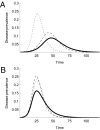Adaptive human behavior in epidemiological models
- PMID: 21444809
- PMCID: PMC3076845
- DOI: 10.1073/pnas.1011250108
Adaptive human behavior in epidemiological models
Abstract
The science and management of infectious disease are entering a new stage. Increasingly public policy to manage epidemics focuses on motivating people, through social distancing policies, to alter their behavior to reduce contacts and reduce public disease risk. Person-to-person contacts drive human disease dynamics. People value such contacts and are willing to accept some disease risk to gain contact-related benefits. The cost-benefit trade-offs that shape contact behavior, and hence the course of epidemics, are often only implicitly incorporated in epidemiological models. This approach creates difficulty in parsing out the effects of adaptive behavior. We use an epidemiological-economic model of disease dynamics to explicitly model the trade-offs that drive person-to-person contact decisions. Results indicate that including adaptive human behavior significantly changes the predicted course of epidemics and that this inclusion has implications for parameter estimation and interpretation and for the development of social distancing policies. Acknowledging adaptive behavior requires a shift in thinking about epidemiological processes and parameters.
Conflict of interest statement
The authors declare no conflict of interest.
Figures



References
-
- Ferguson N. Capturing human behaviour. Nature. 2007;446:733. - PubMed
-
- Kermack WO, McKendrick AG. Contributions to the mathematical theory of epidemics, part 1. Proc R Soc Lond Ser A. 1929;115:700–721.
-
- Anderson RM, May RM. Population biology of infectious diseases: Part I. Nature. 1979;280:361–367. - PubMed
Publication types
MeSH terms
Grants and funding
LinkOut - more resources
Full Text Sources
Medical
Molecular Biology Databases

